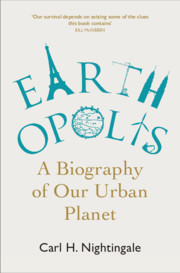Book contents
- Earthopolis
- Earthopolis
- Copyright page
- Dedication
- Contents
- Figures
- Maps
- Introduction Our Urban Planet in Space and Time
- Prologue Before and Beyond: Big Things in Tiny Places
- Part One Cities of the Rivers
- Chapter 1 Making Politics from Sunshine, Earth, and Water
- Chapter 2 Igniting Empire
- Chapter 3 Wealth for a Few, Poverty for Many I
- Chapter 4 Wealth for a Few, Poverty for Many II
- Chapter 5 How Knowledge Became Power
- Chapter 6 The Realm of Consequence
- Part Two Cities of the World Ocean
- Part Three Cities of Hydrocarbon
- Acknowledgments
- Notes
- Index
Chapter 3 - Wealth for a Few, Poverty for Many I
from Part One - Cities of the Rivers
Published online by Cambridge University Press: 10 May 2022
- Earthopolis
- Earthopolis
- Copyright page
- Dedication
- Contents
- Figures
- Maps
- Introduction Our Urban Planet in Space and Time
- Prologue Before and Beyond: Big Things in Tiny Places
- Part One Cities of the Rivers
- Chapter 1 Making Politics from Sunshine, Earth, and Water
- Chapter 2 Igniting Empire
- Chapter 3 Wealth for a Few, Poverty for Many I
- Chapter 4 Wealth for a Few, Poverty for Many II
- Chapter 5 How Knowledge Became Power
- Chapter 6 The Realm of Consequence
- Part Two Cities of the World Ocean
- Part Three Cities of Hydrocarbon
- Acknowledgments
- Notes
- Index
Summary
Chapter 3 of Earthopolis: A Biography of Our Urban Planet discusses the crucial role of cities in enabling small elite groups to amass large pools of wealth while guaranteeing poverty for the large majority of people whose labor made that wealth possible. This is the first of two chapters on the subject. It shows how state actors and wealthy elites controlled rural land and exploited wealth created by agricultural laborers and the energy of the Sun and Earth. It argues that building pre-modern cities and deriving wealth from them always involved the enslavement of millions of laborers for a wide diversity of tasks. Finally, it traces the origins and proliferation of urban artisans, shops, and marketplaces as well as the built hinterlands they required to create smaller pools of wealth in cities. This wealth served as cities’ economic lifeblood despite obstacles artisans and shopkeepers faced within their complex political relationship to urban states and wealthier elites.
- Type
- Chapter
- Information
- EarthopolisA Biography of Our Urban Planet, pp. 83 - 101Publisher: Cambridge University PressPrint publication year: 2022

